You can spot damaged window trim through several signs. Look for cracks and splits, which compromise both appearance and functionality. Peeling paint indicates moisture issues, while warping or bowing can signal poor installation or leaks. Mold or mildew growth shows excessive moisture, and soft or spongy spots suggest potential rot. Don’t ignore visible water stains, gaps between trim and wall, or signs of insect infestation, like small holes or debris. Identifying these issues early can prevent further damage. If you want to know how to address these problems effectively, there’s more information ahead.
Cracks and Splits
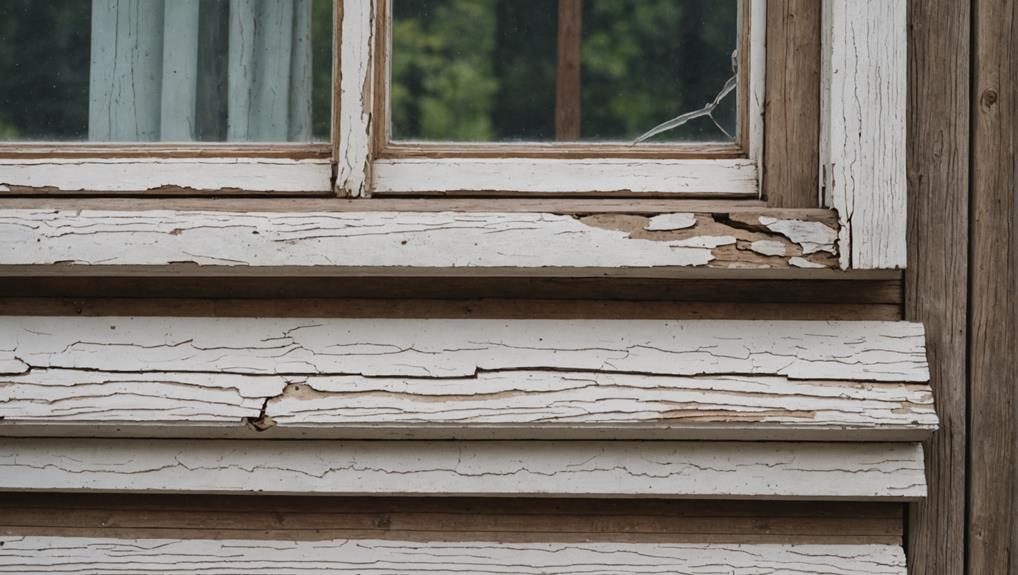
One of the most obvious signs of damaged window trim is the presence of cracks and splits that can compromise both aesthetics and functionality. These imperfections often stem from various causes of cracking, including changes in temperature and humidity. Such changes can lead to the natural expansion and contraction of materials. Over time, this movement can stress the trim, resulting in unsightly fractures.
To prevent these issues, you’ve got to be proactive. First, guarantee proper installation of your window trim to minimize movement. Use high-quality materials that can withstand environmental changes. Additionally, maintaining a consistent indoor climate can help reduce the stress on the trim. Regularly check for signs of moisture buildup or water damage, as these can exacerbate cracking.
Another smart tip is to apply a protective finish or sealant. This not only enhances the look of your trim but also creates a barrier against moisture and temperature changes. By staying vigilant and implementing these prevention tips, you can maintain the integrity of your window trim and avoid costly repairs in the future.
Peeling Paint
Alongside cracks and splits, peeling paint is another clear indicator that your window trim might be suffering from damage. When you notice paint lifting away from the surface, it’s often a sign that moisture has penetrated the wood, compromising its integrity. This can lead to further deterioration if not addressed promptly.
To guarantee good paint adherence, it’s essential to maintain your window trim properly. Start by inspecting the trim regularly for any signs of wear or moisture damage. If you spot peeling paint, don’t just repaint over it; that won’t solve the underlying issue. Instead, remove the peeling paint completely and sand the area to create a smooth surface.
Once you’ve prepared the trim, apply a quality primer to improve paint adhesion and protect against moisture. Follow up with a durable exterior paint that’s designed for wood surfaces.
Adopting these maintenance tips won’t only enhance the appearance of your window trim but also prolong its lifespan. By staying vigilant and proactive, you can prevent further damage and keep your window trim looking its best.
Warping or Bowing
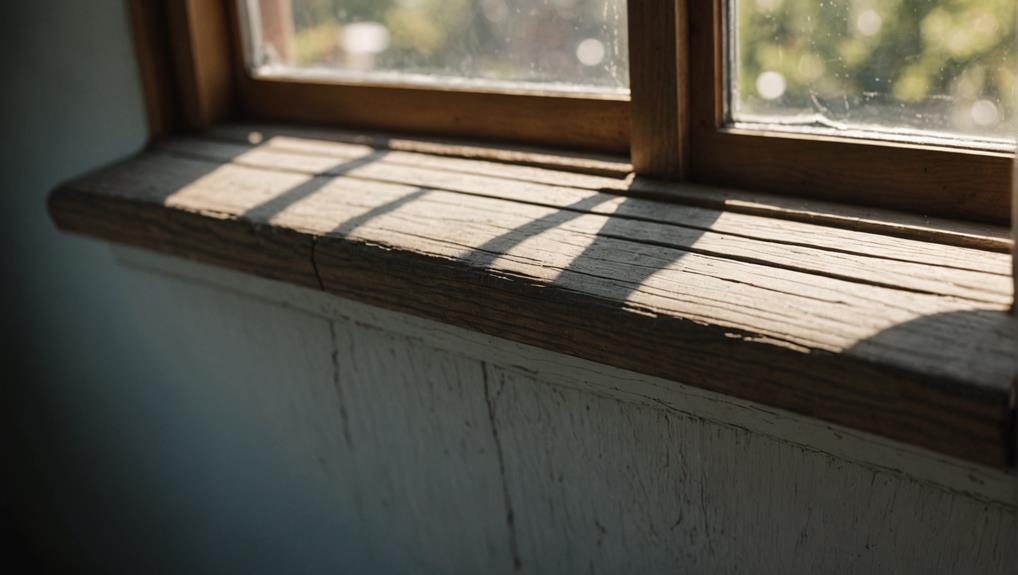
Warping or bowing in window trim often signals underlying moisture issues or poor installation, affecting both aesthetics and functionality. You might notice that your trim has become uneven or isn’t sitting flush against the wall, which is often a sign of trouble.
The causes of warping can include excessive humidity, poor sealing, or even the natural expansion and contraction of materials over time.
To tackle these issues, consider implementing prevention techniques. Start by guaranteeing proper installation, as this lays the foundation for durability. Utilize high-quality, moisture-resistant materials and guarantee they’re adequately sealed.
Regularly inspect your trim for signs of water damage and promptly address any leaks or drainage issues that could lead to moisture accumulation. Additionally, maintaining consistent indoor humidity levels can help reduce the risk of warping.
If you spot warping, don’t ignore it. Addressing the problem early can save you from more extensive repairs down the line. By being proactive and taking the right steps, you can keep your window trim looking great and functioning properly for years to come.
Mold or Mildew Growth
When you notice dark spots or a musty smell around your window trim, it’s a sign that mold or mildew could be growing.
These issues often arise from moisture trapped in damaged areas, and they can pose serious health risks.
Let’s explore how to identify these visual indicators, understand what causes them, and recognize the potential dangers they bring.
Visual Indicators of Mold
You might notice dark spots or a fuzzy texture on your window trim, which often indicate mold or mildew growth. These visual indicators can signal a bigger problem, especially if you see them repeatedly. If you catch this early, you can take action for mold prevention and protect your home.
Another sign to look for is a musty odor around your windows. If you smell something off, it’s likely mold or mildew is hiding somewhere, even if you can’t see it yet. Pay attention to changes in your window trim’s color or texture, too. If it’s warping, peeling, or bubbling, it could be a sign of moisture buildup that leads to mold.
If you suspect mold, act quickly. You can attempt mold removal using specific cleaning solutions, but don’t forget to wear protective gear.
If the issue persists or worsens, consider contacting a professional to assess the situation. Remember, the sooner you identify and address mold, the better chance you have of maintaining a healthy living environment and preventing further damage to your window trim.
Causes of Mildew Growth
Mildew growth often occurs due to excessive moisture, poor ventilation, and humidity levels that exceed normal ranges in your home. When your windows aren’t properly sealed, water can infiltrate and create a damp environment conducive to mildew. If you’ve got areas in your home that don’t receive enough airflow, like corners or spaces behind furniture, it’s even easier for mildew to take hold.
To combat this, you need to focus on moisture control. Regularly check for leaks and make certain your windows are sealed tightly. Use exhaust fans in bathrooms and kitchens to help reduce humidity. You might also want to invest in a dehumidifier, especially in humid climates, to keep moisture levels in check.
Mildew prevention is key. Keep your home well-ventilated, and open windows whenever the weather allows. Make it a habit to dry wet items promptly and avoid leaving damp clothes lying around. By actively managing moisture and ensuring good airflow, you’ll greatly reduce the risk of mildew growth around your windows and throughout your home.
Health Risks Involved
Exposure to mold or mildew can lead to a variety of health risks, especially for those with respiratory issues or weakened immune systems. When your window trim is damaged, it’s more likely that moisture will accumulate, creating an ideal environment for mold growth. This can greatly affect your home’s air quality.
If you’re breathing in air contaminated with mold spores, you might experience symptoms like coughing, sneezing, or even severe allergic reactions. For individuals with asthma or other respiratory conditions, inhaling these spores can trigger flare-ups and make it harder to breathe. You mightn’t even notice the mold right away, as it often thrives in hidden areas behind the trim.
It’s crucial to address any signs of water damage promptly, as neglecting these issues can lead to more extensive mold growth and worsen your window air quality.
Insect Infestation
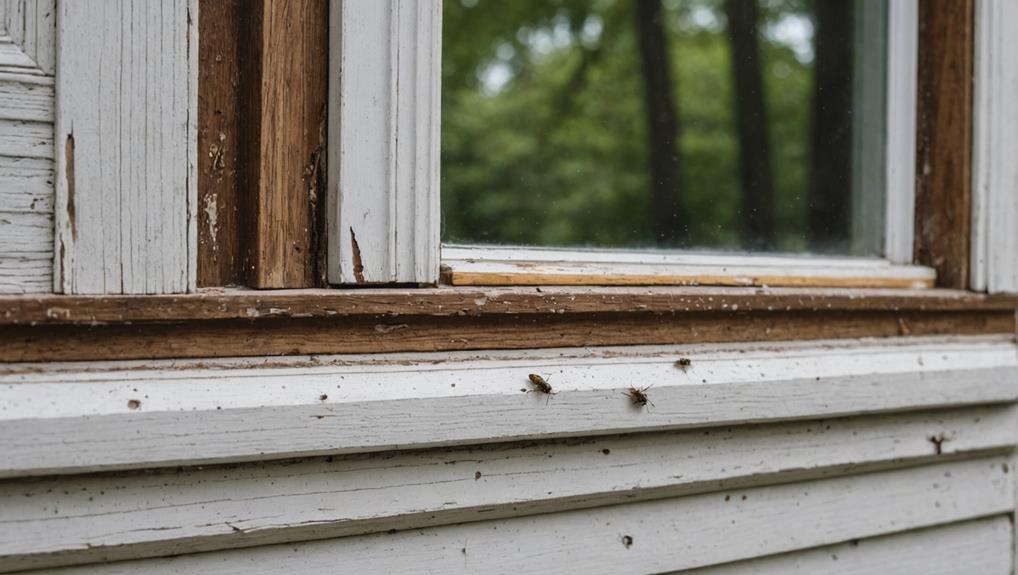
Over time, insect infestations can wreak havoc on window trim, leading to significant structural damage and costly repairs. You might notice signs like small holes, sawdust-like debris, or even the presence of live insects. These indicators suggest that pests, such as termites or carpenter bees, have taken up residence in your trim. Ignoring these warning signs can result in extensive damage, requiring urgent attention.
To manage an infestation, you should consider pest control measures right away. Start by identifying the type of insect causing the damage, as this will inform your treatment options. Some pests may require professional intervention, while minor infestations can be tackled with DIY solutions. Products like insecticidal sprays or wood preservatives can be effective, but always follow the manufacturer’s instructions carefully.
Regular inspections are essential to catch infestations early. Look for signs of damage around your window trim, and don’t hesitate to reach out to pest control professionals if you suspect a major problem. Addressing insect infestations promptly can save you from further damage and guarantee the longevity of your window trim.
Gaps Between Trim and Wall
In addition to insect infestations, you might notice gaps between your window trim and the wall, which can lead to draftiness and moisture issues. These gaps often arise from improper trim installation or shifts in wall alignment over time. If you see these openings, it’s a sign that your window trim may not be securely attached, and this can compromise your home’s energy efficiency.
When gaps form, they allow air to seep in or escape, making your heating or cooling systems work harder. This not only increases your utility bills but can also contribute to potential moisture problems, leading to mold growth or wood rot.
To address this issue, you should first check the alignment of your walls. If they’ve settled or shifted, it might be necessary to re-evaluate the trim installation. You might need to reapply or add caulk to fill the gaps, ensuring a tight seal.
In some cases, you may need to replace the trim altogether if it’s severely damaged or warped. Keeping an eye on these gaps will help maintain your home’s integrity and comfort.
Soft or Spongy Texture
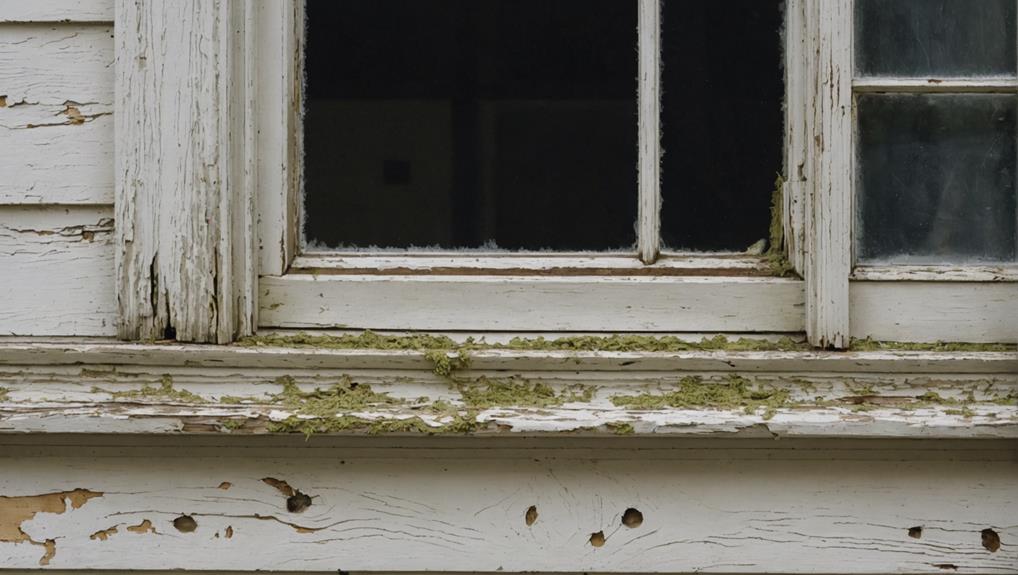
When you inspect your window trim, run your fingers along the surface to feel for any softness or a spongy texture.
If it feels unusual, check for moisture signs, as this could indicate underlying damage.
Addressing these issues early can save you from more extensive repairs down the line.
Feel for Softness
Check the window trim by pressing on it; a soft or spongy texture often indicates water damage or rot. This softness detection is vital for evaluating the health of your window trim. If you notice any give when you press down, it’s a sign that something’s not right. Healthy wood should feel solid and firm, but if it feels mushy or compresses under your touch, moisture may have infiltrated the area.
When performing your moisture evaluation, consider checking around joints and corners where water tends to accumulate. These areas are more susceptible to damage and can reveal underlying issues. Don’t just rely on visual inspections; actively feeling for softness can uncover hidden problems that could lead to costly repairs if left unchecked.
If you find that the trim is soft, it’s important to address the issue promptly. Ignoring it could lead to further decay and potentially compromise the structure of your home. By regularly checking for softness, you can maintain the integrity of your window trim and prevent bigger headaches down the line. Stay proactive and keep your windows in top shape!
Check for Moisture
Finding soft or spongy texture on your window trim often signals moisture problems that need immediate attention. This texture usually indicates that water has infiltrated the wood, leading to deterioration. Identifying the moisture sources is vital for effective moisture detection and repair.
Here are some signs to look for:
- Visible water stains: Check for discoloration around the trim.
- Leaky roofs or gutters: Inspect your roofline and gutters for leaks that could drip onto the trim.
- Condensation: Notice if condensation builds up on the inside of your windows, which could indicate poor sealing.
If you find any soft or spongy areas, it’s important to act quickly. Ignoring these signs can lead to more significant damage, like mold growth or structural issues.
Consider consulting with a professional to assess the situation and repair the damage. Taking these steps will help you maintain the integrity of your window trim and prevent further moisture-related problems.
Water Stains or Damage
Water stains or damage on window trim often signal underlying issues, such as leaks or inadequate sealing, that need immediate attention. If you notice discoloration or peeling paint, it’s essential to act quickly.
Start with water source identification. Check the area around your windows for leaks, particularly during heavy rain. Look for gaps in the caulking or signs of mold, which can indicate moisture intrusion.
Once you pinpoint the source, implement prevention strategies. Reseal any gaps with high-quality caulk or weatherstripping to keep water out. If the damage is extensive, you might need to replace the trim entirely.
Don’t forget to address any underlying issues, like roof leaks or poor drainage, that could be contributing to the problem. Ignoring water stains can lead to more severe damage, including rot and structural issues.
So, take these signs seriously. Regular maintenance and inspections can help prevent future problems, ensuring your windows remain functional and aesthetically pleasing.
Don’t wait until the situation worsens—tackle those stains head-on for a lasting solution.

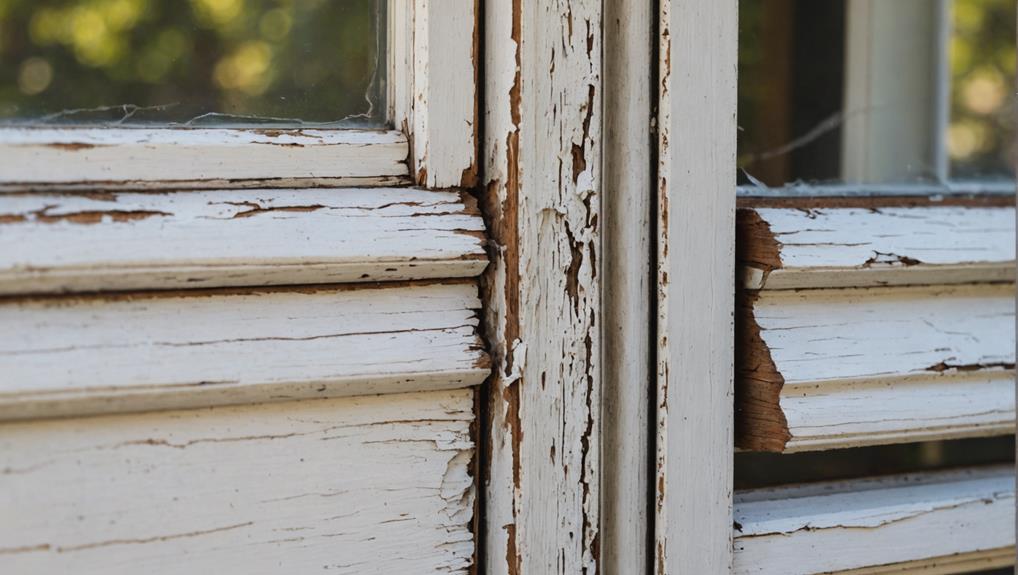
Leave a Reply